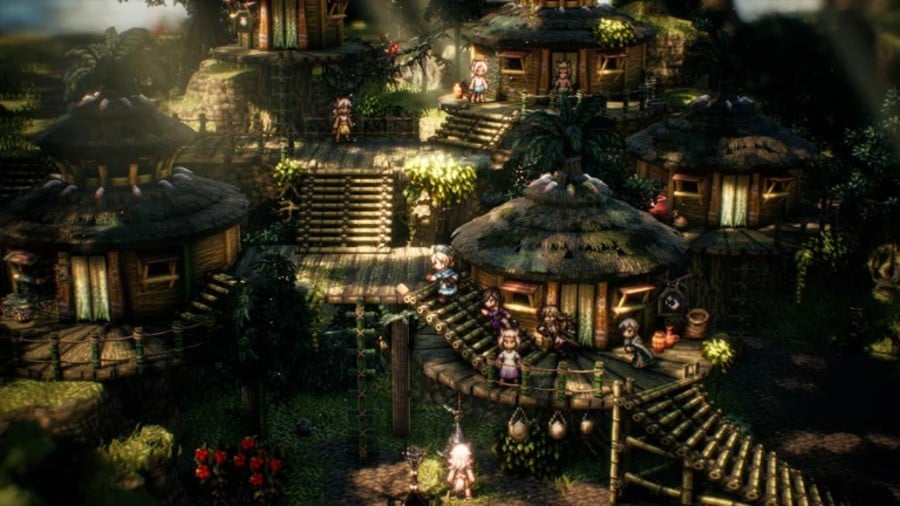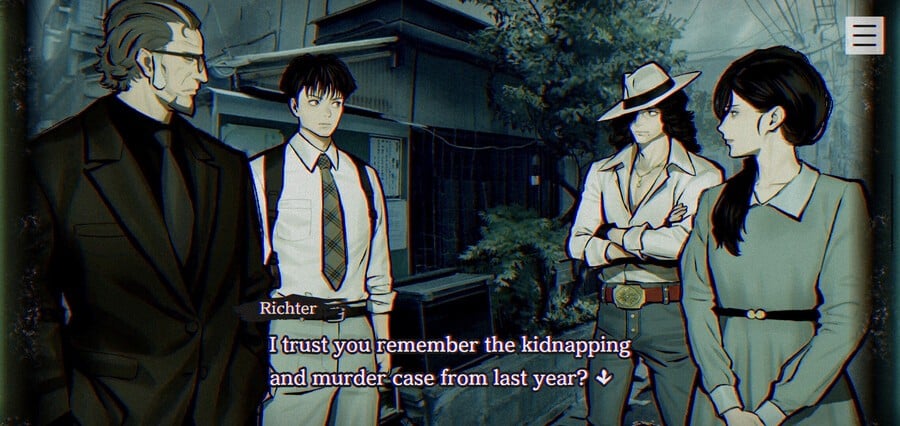
Admittedly, Octopath Traveler II came out after a year full of HD-2D — Triangle Strategy and the Live A Live remake both dropped in 2022, both using those stunning pixel art visuals. Triangle Strategy admittedly is much more niche than a turn-based RPG, and it managed to shift one million copies by the end of 2022, while Live A Live amassed 500k sales on Switch as of September 2022. Not earth-shattering numbers at all, but pretty notable.
To the average player, seeing Octopath Traveler II — the third HD-2D game in 12 months — might cause some fatigue. But if Octopath and these HD-2D projects fall under that ‘smaller’ project umbrella — despite Tomoya Asano saying that the art style “costs more than you think” — is this the end of bigger studios using pixel art visuals? I really hope not.

Games like Harvestella or Paranormasight might not have the broad appeal that the brand of Final Fantasy has nowadays, but the gaming world would be a lot more boring without them. Harvestella might follow in the footsteps of Rune Factory, but for Square Enix to dip its toe into a different sub-genre was fun to see play out. And Paranormasight, developed by indie studio Xeen, felt like a truly unique horror visual novel. but it got hardly any marketing in the West, only being announced during a Japanese Nintendo Direct. And now the ‘sequel’ will be in the form of a comic.
And I think that’s just one of the big problems that have caused Square Enix to post these “extraordinary losses.” Marketing needs to be better for these smaller titles. This huge publisher puts out one of the better visual novels in recent years and it essentially evaporates into the ether? It got extremely good word-of-mouth, but that doesn’t seem to have done much.
Secondly, project-wise, Square Enix just threw everything at the wall, didn’t it? The developer released way too many games between 2021 and 2024. Final Fantasy XIV still continues to be the company’s biggest moneymaker, with Endwalker being a huge hit. But even mainline games like Final Fantasy XVI and, more recently, VII Rebirth, suffer because of the glut of releases, game release delays due to COVID, and the fact that they’re locked to a single console. Concerning that glut — from Dragon Quest Treasures to Infinity Strash, the Pixel Remasters to Crisis Core, Tactics Ogre: Reborn to Minstrel Song, that’s a lot to release over the course of a couple of years. I’m cherry-picking, too. And I know these are all made from different development studios within Square Enix, but there has to be some knock-on effect at some point.

And it seems like “content abandonment losses” is that knock-on effect. We’re going to lose those weird risks that Square Enix sometimes takes, and spreadsheet figures might be better for it. But the richness of the video game industry and the culture it feeds will be diluted as a result, as it has been with the closure of studios like Tango Gameworks, Paladins, and the huge layoffs at Embracer. AAA games are necessary, yes, but so are smaller games.
I want to see more than just crowd-pleasers come out of a big developer.
Of course, I’m speculating here, but as much as I love Final Fantasy (I confess that Rebirth is probably going to be my GOTY, unless Silksong decides to make an appearance), I also love games that take a risk, that feel different, and that dip a toe in experimental waters. Whether that’s changing up the art style, going down a different genre route than expected, or simply taking a punt on a small studio, I want to see more than just predictable crowd-pleasers come out of big companies. It’s part of what has drawn me to Square Enix, and other developers, over the years.
I understand that, at the end of the day, this industry — like most — is all about making money. But video games are diverse, fun, interesting, artistic, and varied. I don’t want to see bigger studios give up on ‘mid-budget’ games. We’ll lose that more human touch that variety and creativity gives us.
NFT games, though? Get outta here. What do you think of Square Enix’s strategy? Let us know down below.
Admittedly, Octopath Traveler II came out after a year full of HD-2D — Triangle Strategy and the Live A Live remake both dropped in 2022, both using those stunning pixel art visuals. Triangle Strategy admittedly is much more niche than a turn-based RPG, and it managed to shift one million copies by the end of 2022, while Live A Live amassed 500k sales on Switch as of September 2022. Not earth-shattering numbers at all, but pretty notable.
To the average player, seeing Octopath Traveler II — the third HD-2D game in 12 months — might cause some fatigue. But if Octopath and these HD-2D projects fall under that ‘smaller’ project umbrella — despite Tomoya Asano saying that the art style “costs more than you think” — is this the end of bigger studios using pixel art visuals? I really hope not.

Games like Harvestella or Paranormasight might not have the broad appeal that the brand of Final Fantasy has nowadays, but the gaming world would be a lot more boring without them. Harvestella might follow in the footsteps of Rune Factory, but for Square Enix to dip its toe into a different sub-genre was fun to see play out. And Paranormasight, developed by indie studio Xeen, felt like a truly unique horror visual novel. but it got hardly any marketing in the West, only being announced during a Japanese Nintendo Direct. And now the ‘sequel’ will be in the form of a comic.
And I think that’s just one of the big problems that have caused Square Enix to post these “extraordinary losses.” Marketing needs to be better for these smaller titles. This huge publisher puts out one of the better visual novels in recent years and it essentially evaporates into the ether? It got extremely good word-of-mouth, but that doesn’t seem to have done much.
Secondly, project-wise, Square Enix just threw everything at the wall, didn’t it? The developer released way too many games between 2021 and 2024. Final Fantasy XIV still continues to be the company’s biggest moneymaker, with Endwalker being a huge hit. But even mainline games like Final Fantasy XVI and, more recently, VII Rebirth, suffer because of the glut of releases, game release delays due to COVID, and the fact that they’re locked to a single console. Concerning that glut — from Dragon Quest Treasures to Infinity Strash, the Pixel Remasters to Crisis Core, Tactics Ogre: Reborn to Minstrel Song, that’s a lot to release over the course of a couple of years. I’m cherry-picking, too. And I know these are all made from different development studios within Square Enix, but there has to be some knock-on effect at some point.

And it seems like “content abandonment losses” is that knock-on effect. We’re going to lose those weird risks that Square Enix sometimes takes, and spreadsheet figures might be better for it. But the richness of the video game industry and the culture it feeds will be diluted as a result, as it has been with the closure of studios like Tango Gameworks, Paladins, and the huge layoffs at Embracer. AAA games are necessary, yes, but so are smaller games.
I want to see more than just crowd-pleasers come out of a big developer.
Of course, I’m speculating here, but as much as I love Final Fantasy (I confess that Rebirth is probably going to be my GOTY, unless Silksong decides to make an appearance), I also love games that take a risk, that feel different, and that dip a toe in experimental waters. Whether that’s changing up the art style, going down a different genre route than expected, or simply taking a punt on a small studio, I want to see more than just predictable crowd-pleasers come out of big companies. It’s part of what has drawn me to Square Enix, and other developers, over the years.
I understand that, at the end of the day, this industry — like most — is all about making money. But video games are diverse, fun, interesting, artistic, and varied. I don’t want to see bigger studios give up on ‘mid-budget’ games. We’ll lose that more human touch that variety and creativity gives us.
NFT games, though? Get outta here. What do you think of Square Enix’s strategy? Let us know down below.







